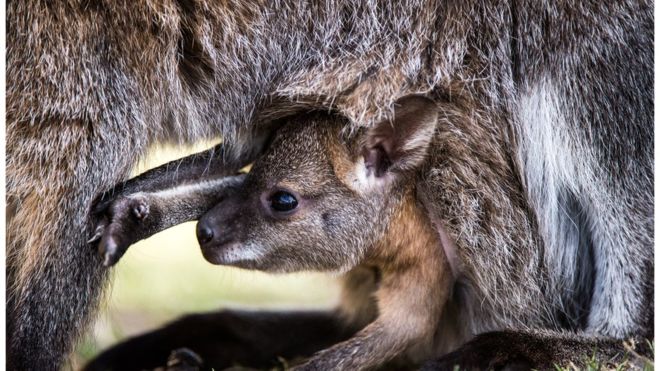The "positional bias" is not unique to humans, with their advanced brains, but is also found in animals, according to researchers in Russia.
Similar behaviour has been seen in baby mammals following their mothers.
They include kangaroos and horses on land and walruses and orcas in the sea.
Dr Yegor Malashichev of Saint Petersburg State University, said the position helped in survival and social bonding.
"If there is no eye contact, or it is wrong, there is no activation of the right hemisphere of the infant... the right hemisphere is responsible for social interactions," she told BBC News.
"All the [11] species we studied demonstrated the lateral bias.
"We suggest that this bias is even more widespread and may be a characteristic of all mammals, with few exceptions. "
Eye contact
It has long been known that humans and great apes tend to cradle their babies on the left, particularly during the first weeks of an infant`s life.
Various explanations have been proposed, including physical contact - so an infant can hear their mother`s heart beat - or practical benefits to the mother, who can keep a hand free for other tasks (if right-handed).
Alternatively, some have proposed it could be related to eye contact and its effect on the brain.
When a mother cradles her baby to the left and face-to-face, the left eyes of the mother and infant are directed towards each other, say the researchers.
Thus, the visual information goes mostly to their right hemisphere of the brain, the side involved in functions such as attention, memory, reasoning, and problem solving (all of which contribute to effective communication).
The researchers looked at humans and 10 wild animals:
- feral horses
- walruses
- reindeer
- antelope
- musk ox
- sheep
- whales
- orca
- kangaroos
The scientists found the young animals kept close to the right side of their mother.
This meant they watched her mainly with their left eye, activating the right hemisphere of the brain.
While doing this, they were less likely to get separated from their mother and more likely to be able to find her again if they got lost.
Animal mothers tended to move to monitor their young with their left eye at times of stress.
For example, the researchers found that orca mothers swam to the right of their infants when the researchers approached them in a boat.
This happened regardless of the side from which the boat was approaching.
This runs contrary to the expectation that the mother would "defend" the infant by placing her body in between the calf and the boat, they say.
Dr Malashichev said the "cradling or positional bias" was not unique to humans or species with advanced brains such as whales but was "really widespread"; so the mechanism was likely to be "ancient and really basic".
The research could also have implications in studying development disorders associated with reduced eye contact between mother and infant, such as autism spectrum disorder, she added.
The study, by teams based in Russia, the US and Australia, is published in Nature Ecology & Evolution.
More about:
















































